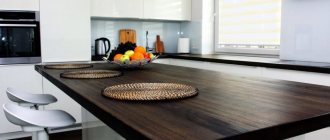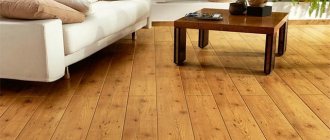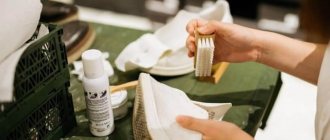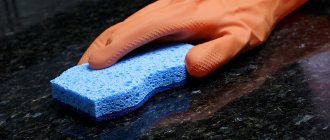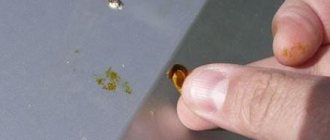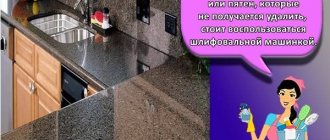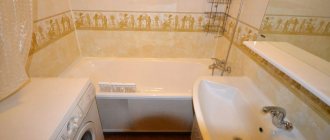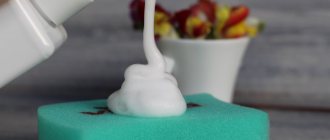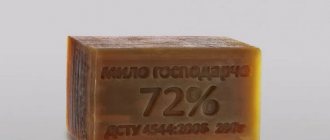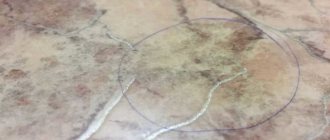Protective layer to prevent stains
Check the protective coating. Splash water on the granite surface and see how it behaves. If the water beads up, the coating is intact. If water spreads over the surface, it’s time to renew the protective coating.
- The coating protects the granite surface from chips and stains.
Clean and dry the countertop thoroughly. Use a cleaner specifically designed for granite. You can buy it at the store or make it yourself from alcohol, dishwashing detergent and clean water.
- Wipe the countertop with cleaner, followed by a clean microfiber cloth dampened with warm water.
- Wipe the countertop with a dry, clean microfiber cloth.
Wait until the surface is completely dry after cleaning before applying a protective coat. Even though you've wiped up the water, it's best to let the countertop dry completely. Wait 10-15 minutes for all the moisture to evaporate from the granite before moving on to the next step.
- The protective layer will adhere less well to the granite surface if it is wet.
Spray the sealant evenly over the surface of the granite. Make sure it covers the entire surface of the granite. It is best to use a spray can for this. Once you've applied the sealant, buff it with a clean microfiber cloth to coat the entire surface evenly.
- Use a granite "penetration" sealer that penetrates into the stone. This sealant can be purchased at a hardware store or ordered online.
- After 15 minutes, wipe off any excess sealant.
The next day, apply a second coat. To properly seal the countertop with a protective layer, apply the sealant again. After one day, wipe the countertop again to keep it clean and wait for it to dry. Spray and rub in a second coat of sealant. After 15 minutes, wipe off any excess sealant.
- You can do without the second layer. However, it will provide a more uniform and durable protective coating.
How to clean the countertop in the kitchen?
The most dirty area in the kitchen is the countertop. Therefore, general cleaning once every three weeks is not enough here. Only daily care will keep this surface clean. If the countertop is made of natural stone, use non-aggressive means, or even better, folk ones. For tools, choose microfiber.
For complex stains on the countertop, there is the following method. For two tablespoons of apple cider vinegar, you will need a couple of drops of each of the aromatic oils: lavender, tea tree and geranium. Apply the product to the sponge and rub the dirt. In addition to the visible result, harmful bacteria and unpleasant odors also disappear.
With an artificial countertop everything is much simpler. It is acceptable to use most products, even abrasive ones. As for chemicals, “Sif” will do an excellent job; among improvised ones, soda and citric acid. How to clean a kitchen apron and walls?
You can wash plastic panels from grease using any of the methods described above for this material. If tiles are laid, proceed as follows.
How to clean wood
This is an aesthetic, environmentally friendly, but rather capricious material to use. A wooden countertop gives the kitchen a special warmth and coziness. But it requires specific care, since wood easily absorbs any liquids and soot and does not tolerate contact with hot objects. How to clean a wooden countertop in the kitchen if it has absorbed grease, been stained by the juice of vegetables or fruits, or simply darkened and become sticky?
In order not to spoil the beautiful surface, before washing the kitchen countertop made of wood, you should evaluate the properties of the material and its reaction to the product used. In most cases, abrasives, strong acids and alkalis are not suitable for cleaning wood. You can use simple folk remedies:
- Salt and vinegar;
- Soda and vinegar;
- Vegetable oil and vinegar;
- Starch or mustard powder;
- Lemon.
Mold on wood is removed with hydrogen peroxide. Any of the products is first applied to the stain with a soft sponge, left to act for 5-10 minutes, then wiped with a clean damp cloth and wiped dry.
Advantages and disadvantages
As a rule, the choice of a stone countertop is determined by its unique aesthetic characteristics; it is difficult to imagine anything more beautiful than natural stone, but we should not forget about their other advantages:
- They can not only withstand heavy mechanical loads, but are also practically immune to high temperatures. With proper use, the service life of natural stone products is practically unlimited;
- do not cause allergies, do not contain toxins and are completely safe for humans;
- the stone surface practically does not absorb moisture, which allows it to maintain its original appearance throughout its entire service life;
- Warm water or soap solution is sufficient for cleaning;
- able to withstand temperatures up to 200 C.
The main disadvantage limiting the use of the material is the high price. It is for this reason that natural stone countertops can be found exclusively in premium interiors. In addition, there are a number of other disadvantages:
- the weight of a product made of natural stone is significantly greater than the weight of a countertop made of any other material, which requires a special approach to the installation and transportation of products;
- restoring damaged products is extremely difficult, and in most cases impossible;
- the working surface always remains cool, but this can hardly be considered a significant drawback;
- in order to maintain the attractive appearance of natural stone products, the rules of care and operation must be strictly followed;
- complexity of installation. Installation most often involves the presence of seams, and high-quality joining of elements can only be done by professionals of the highest class.
How to clean natural stone
We do not recommend looking among aggressive alkalis and industrially produced powders for cleaning a stone countertop. Natural stone is a durable, wear-resistant material, but under the influence of aggressive chemicals it can lose its properties and aesthetic appearance. In order not to damage the porous structure, the stone countertop should be cleaned of dust and dirt daily with a damp microfiber soaked in soapy water. Heavy stains are removed with a mixture of colorless table vinegar and essential oils (geranium, tea tree, lavender).
Removing splashes and stains
Blot up any spilled liquid with a paper towel. If you spill something on the countertop, immediately blot up the liquid with a paper towel. Do not rub the liquid over the surface. Even plain water can stain granite, so the liquid should be removed immediately.
- Use a clean paper towel to avoid further contaminating the surface. You can also use a clean microfiber cloth.
Use hot water and a little dish soap to clean up spills. Fill a mug or heatproof cup with hot water. Add a few drops of mild dish soap and stir the water until it dissolves. Pour some solution onto the stained area and wipe it off with a clean microfiber cloth.
- Repeat until you get rid of the stain.
Use a baking soda paste to remove the oil stain. Take a small cup and use a spoon to mix three parts baking soda and one part water. Apply the resulting paste to the contaminated area and rub it with a clean cloth.
- This mixture will also help remove old oil stains.
Try removing juice or water stains with hydrogen peroxide. If the liquid has left a stain on your countertop, mix three parts hydrogen peroxide to one part water. Pour the solution onto the dirty area and rub it with a clean rag.
- Rub the solution in light circular motions.
Wipe the surface with water. Dampen a clean rag with water and rinse off any remaining cleaner from the granite surface. Wipe down the countertop until all dirt and cleaner are removed.
- Wipe the countertop with a dry microfiber cloth to remove any remaining water.
What not to do with artificial stone
- Do not place hot pots, pans and other utensils, as well as heating electrical appliances, on the countertop
- Do not drop heavy or sharp objects on the countertop
- Do not cut foods on the surface without using a cutting board.
Thus, caring for an artificial stone countertop is not particularly difficult, and with proper attention, this piece of furniture will delight you for many years.
In the kitchen, things are regularly fried and baked using various types of oils. When the fat becomes hot, it begins to smoke, some of it evaporates and settles on the kitchen furniture. The longer foods are processed, the thicker the oil they are cooked in and the more viscous the coating. Gradually it mixes with dust, compacts and firmly connects to surfaces. It becomes difficult to remove a layer of such contamination, and the question of how to clean the kitchen from grease on the cabinets becomes an urgent problem.
How to remove marks from hot objects?
If it does happen that the hot frying pan “landed” on the table, and traces of thermal effects appear on the surface, then you can try to remove them:
- from a wooden surface using polish;
- from plastic countertops using a special solvent for PVC;
- from artificial stone - products that contain ammonia.
Natural stone, as a rule, will not suffer from short-term thermal exposure, but it is best to use special stands.
Remember that proper and timely care of your kitchen countertop can significantly extend its service life and delight you with its fresh appearance.
How to clean a quartz countertop
As with acrylic countertops, stains should be removed immediately to make cleaning much easier and avoid the need for special products.
To maintain the ideal appearance of a kitchen countertop made of quartz agglomerate, it is enough to follow a few simple rules:
- Quartz products practically do not absorb moisture (the moisture absorption coefficient is only 0.02%), so the formation of stains from spilled liquids is practically excluded. Despite this, tea, coffee, red wine and other stains should be removed immediately, since, with prolonged exposure, the liquid can still penetrate into the structure of the material;
- Despite the fact that countertops made of quartz agglomerate can withstand temperatures up to 200 C, you should not place hot kitchen utensils on the work surface.
- Although the hardness and strength of the material is extremely high, a strong blow from a metal or stone object can cause microcracks and even chips. You should also not use the countertop as a cutting board: this will not lead to mechanical damage, but it may deprive the work surface of its gloss.
- Generally, all you need to clean a quartz countertop is a cloth and clean, warm water. When more complex contaminants appear, it is allowed to use liquid detergents that do not contain abrasives, chlorine and alkalis.
- You can use denatured or isopropyl rubbing alcohol to remove ink stains, markers, and food coloring stains. In this case, after treatment, the surface must be thoroughly rinsed with clean water and wiped with a dry cloth.
Plastic
Kitchen worktops with plastic coating are the most budget-friendly and, accordingly, the most common. Plastic is easily damaged by hot pans and pots, so do not forget to use special stands. It is easy to care for plastic using a regular damp cloth.
Using laundry soap, you can remove any type of dirt, including the oldest stains.
Caring for the surface of your kitchen countertop, made of any material, should become your daily good habit or evening ritual.
Cleaning and disinfection
Use warm water and dishwashing detergent to wipe. Fill a sink or small bucket with warm water. It is best to use warm water to clean granite. Add some liquid mild dish soap and stir the water lightly until it dissolves.
- The exact proportion is not important. Just make sure the water becomes a little soapy.
Wipe the countertop once a day with a clean white cloth. To clear the countertop, remove all appliances and dishes from it. Soak a rag in the dish soap and water solution, then squeeze out the excess water. Wipe off all crumbs and other food debris from the countertop.
Mix alcohol with water to disinfect countertops. Fill a spray bottle with water and 91 percent isopropyl alcohol in a 1:1 ratio. Screw on the cap and gently shake the bottle to mix the alcohol with the water.
Spray the countertop with a disinfectant solution every few days. Use a spray bottle to spray the solution evenly over the surface. Apply the solution to the entire countertop and do not skip individual areas. Wait 3-5 minutes for the disinfectant solution to take effect.
- You don't have to leave the solution on the countertop if you don't intend to disinfect it.
Dry the countertop after wiping off the solution. Dip the rag into the soapy water again. Wipe down the countertop to remove any disinfectant solution. If desired, you can then wipe the countertop with a cloth soaked in clean water.
- Wipe the countertop with a dry cloth to give it a shine.
Do not use acidic cleaners on granite surfaces. Products containing ammonia, vinegar or lemon juice contain acid and can damage granite. However, you can use citrus essential oils as they have a neutral pH level.
Removing splashes and stains
Blot up any spilled liquid with a paper towel. If you spill something on the countertop, immediately blot up the liquid with a paper towel. Do not rub the liquid over the surface. Even plain water can stain granite, so the liquid should be removed immediately.
- Use a clean paper towel to avoid further contaminating the surface. You can also use a clean microfiber cloth.
Use hot water and a little dish soap to clean up spills. Fill a mug or heatproof cup with hot water. Add a few drops of mild dish soap and stir the water until it dissolves. Pour some solution onto the stained area and wipe it off with a clean microfiber cloth.
- Repeat until you get rid of the stain.
Use a baking soda paste to remove the oil stain. Take a small cup and use a spoon to mix three parts baking soda and one part water. Apply the resulting paste to the contaminated area and rub it with a clean cloth.
- This mixture will also help remove old oil stains.
Try removing juice or water stains with hydrogen peroxide. If the liquid has left a stain on your countertop, mix three parts hydrogen peroxide to one part water. Pour the solution onto the dirty area and rub it with a clean rag.
- Rub the solution in light circular motions.
Wipe the surface with water. Dampen a clean rag with water and rinse off any remaining cleaner from the granite surface. Wipe down the countertop until all dirt and cleaner are removed.
- Wipe the countertop with a dry microfiber cloth to remove any remaining water.
Protective layer to prevent stains
Check the protective coating. Splash water on the granite surface and see how it behaves. If the water beads up, the coating is intact. If water spreads over the surface, it’s time to renew the protective coating.
- The coating protects the granite surface from chips and stains.
Clean and dry the countertop thoroughly. Use a cleaner specifically designed for granite. You can buy it at the store or make it yourself from alcohol, dishwashing detergent and clean water.
- Wipe the countertop with cleaner, followed by a clean microfiber cloth dampened with warm water.
- Wipe the countertop with a dry, clean microfiber cloth.
We wash the most difficult parts - handles and other fittings with steam cleaners
Hardworking housewives purchase special steam cleaners for their home. This technique removes all types of contaminants from various surfaces and disinfects them. The device is suitable for processing any type of wood, plastic, small fittings, cutlery, etc.
The device acts on contamination with steam, which affects the structure of the fat deposit, making it soft and liquid. As a result of operation, you will be able to clean:
- kitchen facade, electrical appliances, tables and walls from grease splashes;
- restore shine to glass or stainless steel utensils;
- remove scale and burnt marks from pans;
- remove foul odor, bacteria and fungi.
The device does not require the use of oilcloth, but allows you to wipe off stains of varying complexity and age from the table, walls, cabinet handles, gas boiler, laminate, chipboard, MDF and laminated chipboard.
You can clean the kitchen from greasy stains using household and traditional methods. Before processing, be sure to determine what material it is made of. If the furniture is varnished, avoid using abrasives such as soda and mustard. For other kitchens, as well as walls, tiles, and ceilings, any cleaning method is suitable.
conclusions
Cleaning any kitchen from grease or other types of dirt is a completely simple task. You just need to approach the matter responsibly and do everything possible following the instructions. The result will be pleasantly surprising.
Countertops and sinks made of artificial stone have long gained popularity, because they harmoniously combine attractive appearance, functionality and affordability. This material is characterized by high strength and durability, resistance to moisture, wear and high temperatures, dense uniform structure and aesthetics.
In addition, it does not require complex care. In this article we will look in detail at how and with what to wash artificial stone countertops.
Types of MDF facades and cleaning methods
Before cleaning your kitchen from accumulated grease and dirt, it is important to understand what material it is made of. This will allow you to choose the right cleaning product.
The most popular cuisines are from:
- wood;
- laminated chipboard;
- plastic;
- glass
Each material has its own cleaning methods. It is convenient to wash plastic and glass facades with alkaline, salt and soda agents; with oil and soda, ammonia and hydrogen peroxide – wooden, MDF, chipboard and laminated chipboard.
